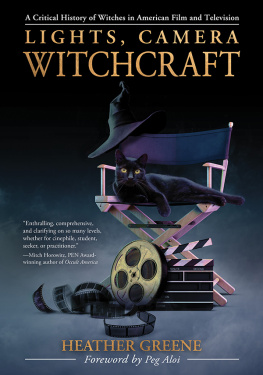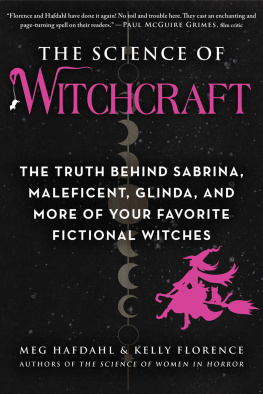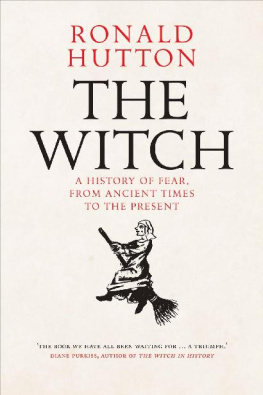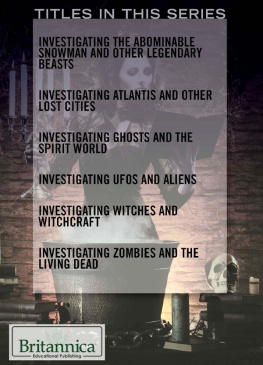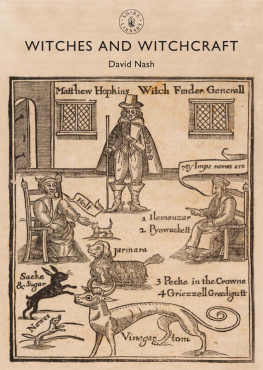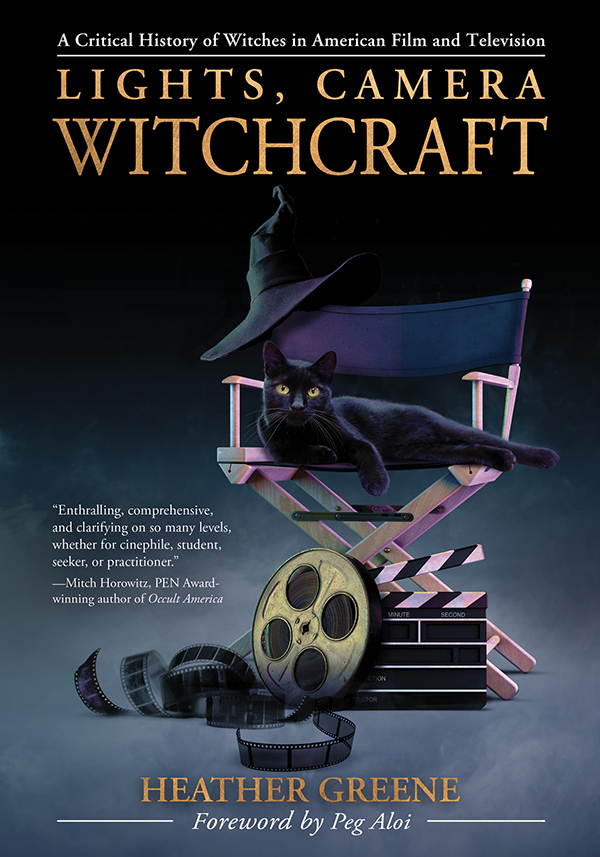Heather Greene is a freelance writer, journalist, and editor. She received a BA in film at Wesleyan University and an MA in film studies from Emory University. She also studied film and theater at Cornell University and the University of Paris. She has written for Religion News Service, Turner Classic Movies, The Wild Hunt , Circle Magazine , Patheos.com, and other outlets. She is a member of Circle Sanctuary, Covenant of the Goddess, and the Religion Newswriters Association.

Llewellyn Publications
Woodbury, Minnesota
Copyright Information
Lights, Camera, Witchcraft: A Critical History of Witches in American Film and Television 2021 by Heather Greene.
All rights reserved. No part of this book may be used or reproduced in any matter whatsoever, including Internet usage, without written permission from Llewellyn Publications, except in the form of brief quotations embodied in critical articles and reviews.
As the purchaser of this e-book, you are granted the non-exclusive, non-transferable right to access and read the text of this e-book on screen. The text may not be otherwise reproduced, transmitted, downloaded, or recorded on any other storage device in any form or by any means.
Any unauthorized usage of the text without express written permission of the publisher is a violation of the authors copyright and is illegal and punishable by law.
First e-book edition 2021
E-book ISBN: 9780738768809
First Edition: Bell, Book, and Camera: A Critical History of Witches in American Film and Television Heather Greene, McFarland & Company, 2018.
Second Edition, Expanded and Revised
Art credit list on
Book design by Samantha Peterson
Cover design by Shannon McKuhen
Cover illustration by Dominick Finelle
Llewellyn Publications is an imprint of Llewellyn Worldwide Ltd.
Names: Chauran, Alexandra, author.
Title: Modern guide to mudras : create balance and blessings in the palm of
your hands / Alexandra Chauran.
Description: First edition. | Woodbury, Minnesota : Llewellyn Publications,
2021. | Includes bibliographical references. | Summary: Modern Guide to
Mudras teaches how to use hand gestures for worship, meditation,
spellcasting, sacred movement, and ritual storytelling Provided by publisher.
Identifiers: LCCN 2021033546 (print) | LCCN 2021033547 (ebook) | ISBN
9780738767666 (paperback) | ISBN 9780738767765 (ebook)
Subjects: LCSH: Magic. | GestureMiscellanea. | Gesture in worship. |
Meditation. | Mudrs (Buddhism) | Mudrs (Hinduism)
Classification: LCC BF1623.G47 C43 2021 (print) | LCC BF1623.G47 (ebook)
| DDC 133.43--dc23
LC record available at https://lccn.loc.gov/2021033546
LC ebook record available at https://lccn.loc.gov/2021033547
Llewellyn Publications does not participate in, endorse, or have any authority or responsibility concerning private business arrangements between our authors and the public.
Any Internet references contained in this work are current at publication time, but the publisher cannot guarantee that a specific reference will continue or be maintained. Please refer to the publishers website for links to current author websites.
Llewellyn Publications
Llewellyn Worldwide Ltd.
2143 Wooddale Drive
Woodbury, MN 55125
www.llewellyn.com
Manufactured in the United States of America
Magic is creating what you dream.
Dont ever stop dreaming.
This book is dedicated to my parents, who
taught me to always believe in magic.
To my partner in all things
and to my wonderfully eclectic children.
Contents
by Peg Aloi
: In the Beginning (18981912)
: Mystical Adolescence and the Wild Girl (19131920)
: New Woman, True Woman (19211933)
: Wild Women, Vamps, and Green Skin (19341940)
: War and Weird Women (19411950)
: Bell, Book, and Satan (19511960)
: Toward a New Hollywood (19611968)
: Horror and Exploitation (19691978)
: The Rise of Conservatism (19791986)
: The Satanic Panic (19871998)
: Wiccans, Ghosts, and Teen Witchery (19992010)
: A New Witch Order (20112020)
Acknowledgments
There have been many people who have supported this project and allowed me the time to walk through this magical journey of cinematic witchcraft. Id like to thank, first and foremost, my family who left me alone to watch endless hours of movies and endured my nonstop chatter on the subject. Their unconditional support and love are inspiring and can never be repaid.
I also want to acknowledge a few people who took time for personal correspondence to clarify and assist with various topics, including Bill Krause, Hanna Grimson, and the entire team at Llewellyn Worldwide, Thomas Doherty, Philip Heselton, Steven Intermill, Dr. Emerson Baker, Ashley Mortimer, Rev. Selena Fox, Jason Mankey, Eric Stedman, Adam Simon, Chika Oduah, Michael Henry, Jerry Murbach, Bob Sennett, Emily Uhrin, Anna Biller, Tomas Zurek, Sean Bridgeman, Geraldine Beskin, and Jeff Miller.
Im sure there are others. It has been a long road, and projects like this cannot be done without a team of excellent people pushing them along.
Foreword
Witches seem to be everywhere in twenty-first century America: at the movies, on television, in comics, cartoons, literature, music, video games, and advertising. Indeed, witches are so pervasive in popular culture that we barely notice them anymore, and it seems barely a month goes by without a new witchy series, film, comic, or video game arriving on the scene. Weve seen this before in the occult revival of the 1960s and 70s, in the New Age witchcraft of the 1980s, and in the Hollywood-fueled witchcraft obsession of the 1990s. Since the late 1990s, witches have also invaded the internet, and in more recent years, our newest form of media: social media. Witchcraft is now not only a subject for entertaining fiction but a widely disseminated form of self-care and social engagement. Its hard to say how we got here, but theres no question that the witches of film and television have been with us for the entire journey.
Beginning with her introduction, Heather Greene reminds us that the figure of the witch is nothing if not complex and contradictory: The witch archetype, she says, exists in two modes: one of oppression and one of empowerment. As well, the witch is someone who changes and adapts to the times she inhabits: our view of witches historically is difficult to separate from our contemporary view of them. This is one reason why Lights, Camera, Witchcraft is such a valuable contribution to scholarship: it has such a specific focus on the historical and cultural context of witches in entertainment media. The historical evolution of the witch, it turns out, is a significant factor in how she is portrayed in both historical and contemporary narratives; for example, what we now know about the witch craze in medieval Europe or the North American witchcraft persecutions shifts frequently as more scholars pursue research in the social sciences, archaeology, and other fields.
Clearly a contemporary witch in 1939 (such as the Wicked Witch of the West, played by Margaret Hamilton in The Wizard of Oz ), arriving in the midst of war and economic strife, has a completely different cultural context compared to the witch who appears in 1987 (like the trio of women in the film adaptation of John Updikes novel The Witches of Eastwick ), at a time when the nation is experiencing economic growth and the decadence and inequity that often accompanies it. Seeing witches inhabit our modes of entertainment through the decades of the twentieth century and beyond, we begin to see she has always been with us, bewitching us on the silver screen, beckoning us to keep watching from the couch late into the night. The witch pervades the horror genre too, and no exploration of horror would be complete without considering the witchs role.

